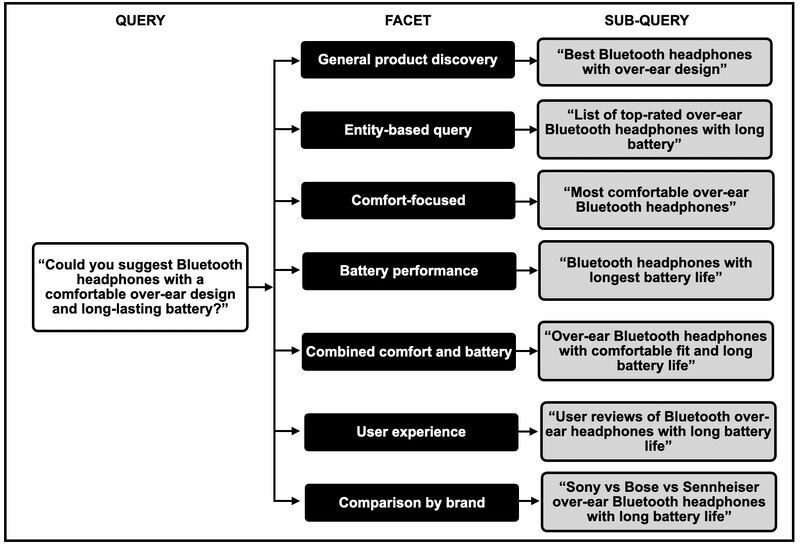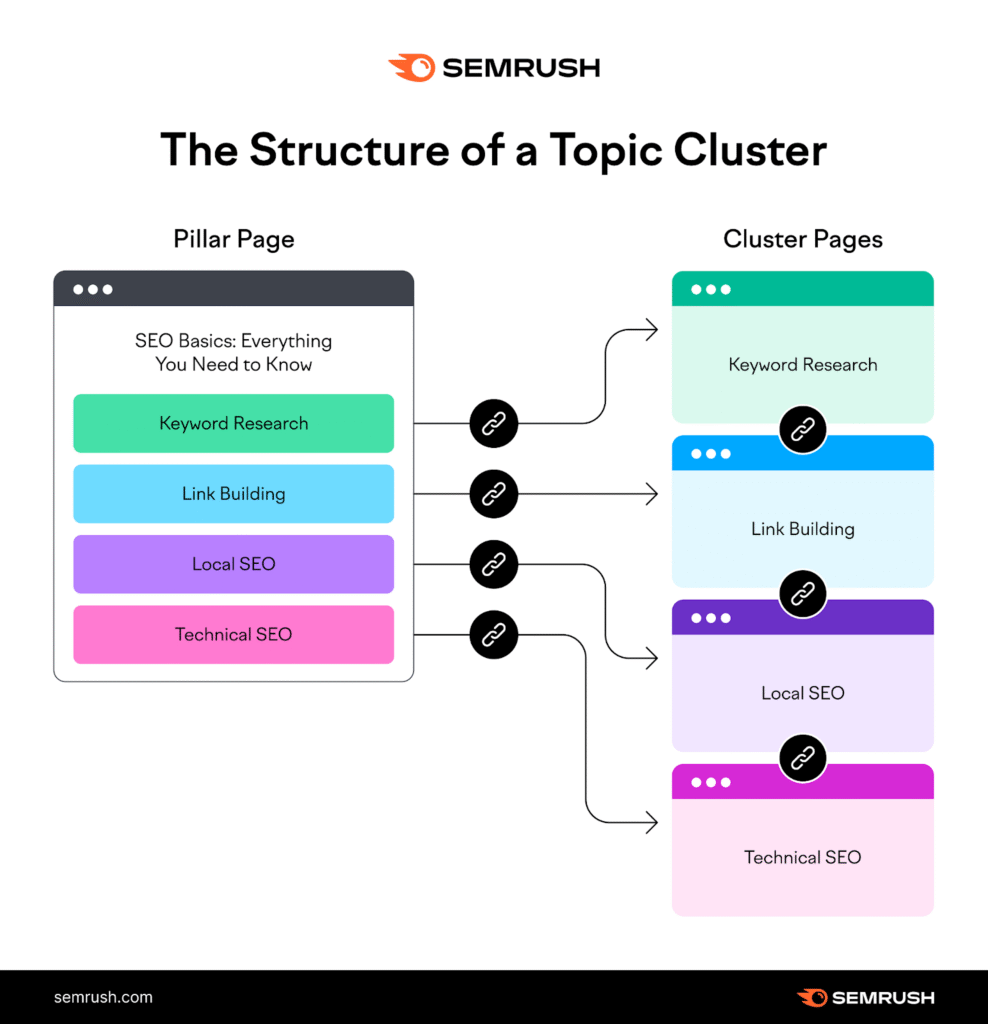You’ve spent years mastering the rules of Google.
You’ve optimized your pages, chased keywords, and built links. You fought your way onto the first page, maybe even into the top three spots. But while you were focused on climbing that ladder, Google replaced the ladder entirely.
There’s a silent, seismic shift happening under the surface of every search bar, and most marketers are still blind to it. It’s not about algorithm updates or Core Web Vitals. It’s a fundamental rewiring of how Google discovers and presents information.
It’s called query fan-out, and it’s the engine behind Google’s AI Overviews and AI Mode. If you don’t understand how it works, your content is at risk of becoming invisible—overnight.
Understanding the Query Fan-Out Technique
Imagine you’re a lead detective assigned a complex case. You wouldn’t just follow one lead, would you? You’d dispatch a team of specialist investigators—one to the crime scene, one to forensics, one to interview witnesses, and another to check alibis.
That’s precisely what query fan-out does.
When a user types a complex or multi-layered question into Google’s AI Mode, the system no longer just looks for a single webpage that matches those words. Instead, it acts like that lead detective.
It deconstructs the user’s single query into multiple, highly specific sub-queries. Each of these sub-queries is a separate line of investigation, dispatched simultaneously across the vastness of the web, Google’s Knowledge Graph, and its shopping data. One sub-query might investigate a historical aspect, another might look for product comparisons, and a third might seek out “how-to” instructions.

The AI then gathers all the intelligence from these separate investigations and synthesizes it into a single, comprehensive answer—the AI Overview you see at the top of the results. This isn’t just a search. It’s an automated research project, executed in milliseconds. And it changes everything.
How Query Fan Out Changes Traditional Search
To grasp the magnitude of this shift, you have to understand how different it is from the traditional search process we’ve known for two decades.
The Old Way was a Matching Game
Traditional Google Search was fundamentally a matching game. You typed in a query, and the algorithm’s primary job was to find the single best document in its index that matched your keywords and inferred intent. It was a one-to-one process: one query, one list of ten blue links, ranked by factors like authority, backlinks, and on-page keywords. The ultimate prize was ranking #1 for that specific query.
The New Way is a Synthesis Engine
AI Mode with query fan-out operates on a completely different principle. It’s a one-to-many process. Your single query spawns dozens of micro-queries behind the scenes. The goal is no longer to rank one document but to extract information from many documents to construct a single, cohesive answer.
This marks a profound shift in focus from ranking pages to sourcing information. Google isn’t just a librarian pointing you to the right bookshelf anymore; it’s a researcher reading multiple books and handing you a summary report. Your content’s new job is to be so clear, authoritative, and useful that it gets cited in that final report. This has led to new form of SEO such as AEO, GEO, and LLM Optimization.
What Query Fan-Out Means for Your Content
The implications of this shift from a matching engine to a synthesis engine are not theoretical. They are actively changing who wins and who loses in search.
- The “Single Keyword” Mindset is Obsolete: Obsessing over a single primary keyword for a page is now a dangerously outdated strategy. A user’s broad query about “best home coffee makers” might fan out into sub-queries like “drip vs. espresso machines,” “coffee maker maintenance tips,” “most durable coffee maker brands,” and “eco-friendly coffee machines.” If your single page only targets the main keyword, you’re missing the dozen other opportunities to be seen.
- Niche Expertise is Now a Superpower: This is the silver lining. Query fan-out actively seeks out hyper-specific answers. That in-depth blog post you wrote explaining the precise difference between burr grinders and blade grinders? It might have been too niche to rank for a broad term before. Now, it’s the perfect piece of evidence for a sub-query, ready to be pulled into a larger AI Overview. Deep, granular content is no longer a liability; it’s a primary asset.
- The Goal Shifts to Being Part of the Answer: For years, the coveted spot was the featured snippet, or “Position Zero.” The new prize is to be cited as a source within the AI Overview. This means even if you don’t “rank” in the traditional sense, a passage, a statistic, or a single clear answer from your page can be extracted and featured, earning you visibility and brand association.
- Your Competitors Are Now Everywhere: You’re no longer just competing with the five other blogs in your niche. You’re competing with a Reddit thread that has a real-world user experience, a product page with detailed specs, a forum with troubleshooting advice, and a YouTube video with a clear demonstration. The AI doesn’t care about the source’s format; it only cares about the quality and relevance of the information it can extract for its sub-queries.
Actionable Strategies to Optimize for Query Fan Out
You can’t fight this change, but you can adapt your strategy to thrive in it. Optimizing for query fan-out requires moving beyond traditional SEO and embracing a more holistic content approach. Here is your new playbook.
Strategy 1: Build Topic Clusters, Not Just Pages

The concept of topic clusters is no longer a “nice to have”—it is the fundamental architecture for success. A topic cluster involves creating a central “pillar” page for a broad subject (e.g., “Digital Photography Guide”) and surrounding it with multiple “cluster” pages that cover specific sub-topics in detail (e.g., “Understanding ISO,” “Choosing the Right Lens,” “RAW vs. JPEG Explained”).
Why it works: When a user asks a broad question, Google’s AI “fans out” into sub-queries that perfectly align with your individual cluster pages. A well-structured topic cluster essentially hands the AI a pre-made, interconnected map of your expertise, making it incredibly easy for it to find and synthesize authoritative information from your domain.
Strategy 2: Answer Every Possible Question
Your content needs to anticipate and answer every conceivable follow-up question. Don’t just explain what something is; explain how it works, why it matters, how to fix it when it breaks, and how it compares to alternatives.

Use tools like Google’s “People Also Ask,” browse forums like Reddit and Quora, and listen to your own customer service team. Every question they hear is a potential sub-query that Google’s AI will be looking to answer. Each of those answers can be a dedicated section in a larger article or its own cluster page, ready to be discovered.
Strategy 3: Structure Content for AI Consumption
Your content must be ruthlessly organized. An AI doesn’t “read” for pleasure; it parses for data. You need to make your information as easy to extract as possible.
- Use Crystal-Clear Headings: Structure your articles with a logical hierarchy of H2s, H3s, and H4s. These act as signposts for the AI, helping it understand the structure and importance of your information.
- Leverage Schema Markup: This is non-negotiable. Implement schema like FAQPage, HowTo, and QAPage. Schema is structured data that acts as a cheat sheet for search engines, explicitly telling them what a piece of content is about, making it trivial to extract.
- Embrace Lists and Tables: Bullet points, numbered lists, and data tables are highly structured formats that AI can easily digest and repurpose. If you’re comparing products or listing steps, use these formats.
- Write “Atomic” Answers: Within your content, provide concise, direct answers to specific questions. Think of each paragraph or section as a potential standalone snippet. Start a section with a direct answer, then elaborate.
Strategy 4: Reinforce Your Authority with EEAT
In a world where AI is the gatekeeper, trust signals are more critical than ever. When the AI model evaluates multiple sources to answer a sub-query, it will naturally prioritize content that demonstrates high levels of Experience, Expertise, Authoritativeness, and Trustworthiness (E-E-A-T).
This means author bios that showcase credentials, original research and data, case studies with real results, and clear sourcing for all claims are no longer just “good practice.” They are essential ranking factors for being included as a trusted source in an AI-generated response.
The Risks of Ignoring This Fundamental Shift
Sticking to old SEO tactics in this new era isn’t just ineffective; it’s a recipe for digital extinction.
- Guaranteed Invisibility: Your beautifully written, 3,000-word comprehensive guide might be completely ignored. If it’s not structured for easy data extraction, the AI will simply bypass it and pull atomic answers from five of your competitors who made their content more digestible.
- Traffic Sabotage: You could hold the #1 traditional rank and still lose all your traffic. If the AI Overview, built using query fan-out from competitor sites, provides a complete answer, the user has no reason to click your link. Your top ranking becomes a vanity metric as you fall victim to a zero-click search.
- Content Commoditization: If your content is generic and offers no unique data, perspective, or experience, you are easily replaceable. The AI will find a dozen other sources just like you and will feel no loyalty. Unique insights are your only moat.
Conclusion: Prepare for Generative Engine Optimization
The ground has permanently shifted. The game is no longer about tricking an algorithm into giving you the top spot. It’s about becoming such an undeniable authority on a topic—with deep, well-structured, and trustworthy content—that Google’s AI has to cite you.
This is the dawn of Generative Engine Optimization (GEO). It requires you to think less like a keyword-stuffer and more like a librarian, meticulously organizing your knowledge for a new kind of patron: the AI itself.
The choice is stark. You can either learn the new rules and build a content strategy that feeds the generative engine, or you can cling to the old ways and watch as your visibility, traffic, and relevance are synthesized out of existence. The ones who adapt now will build the trusted brands of tomorrow. The ones who don’t will become footnotes on a search page they no longer recognize.


